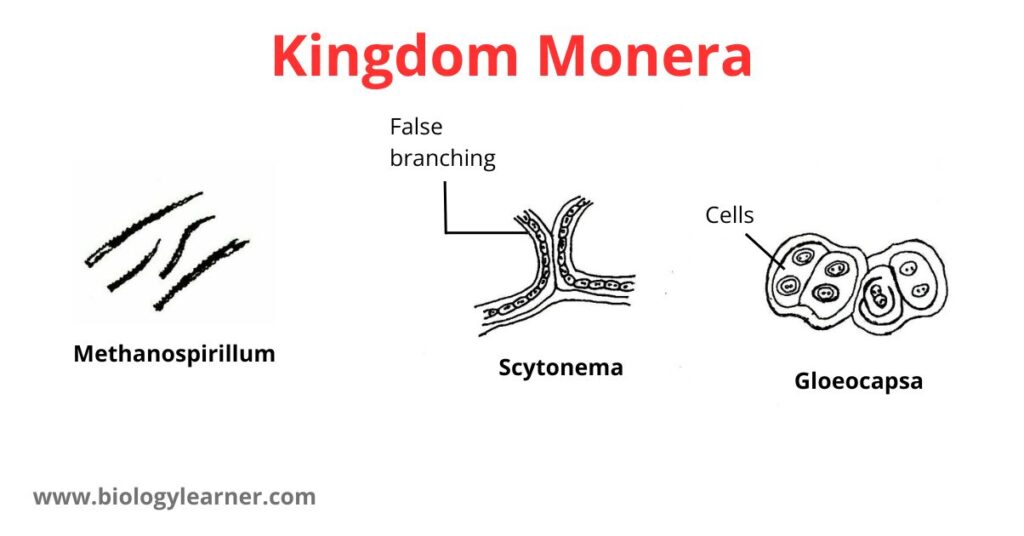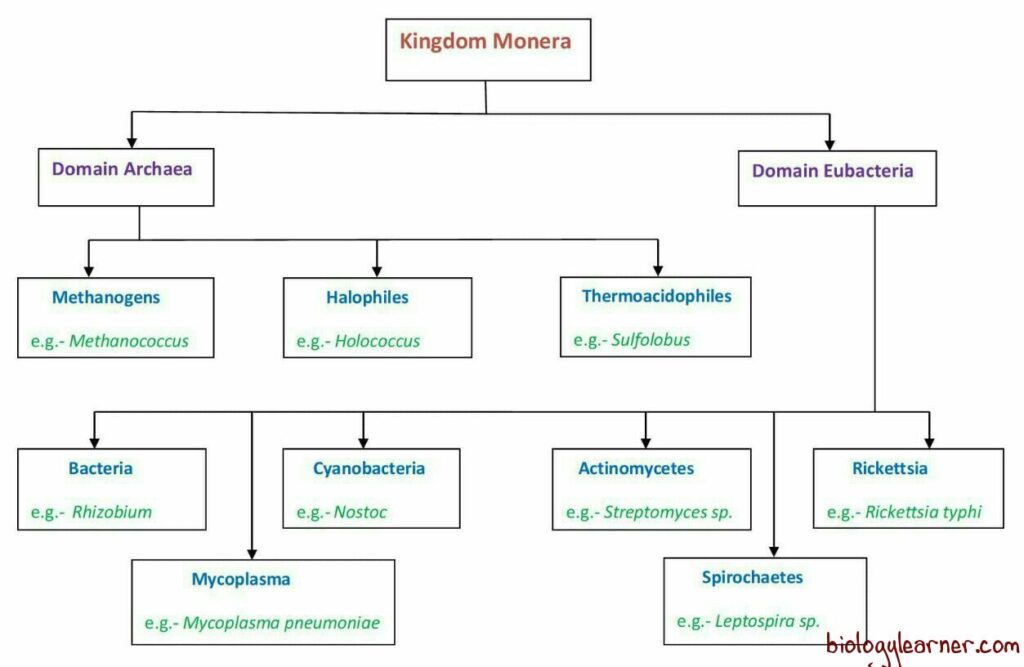Whittaker in 1969, proposed a new five Kingdom arrangement of organisms based on the complexity of cell structure, the complexity of the organism’s body, and the mode of obtaining nutrition. The Five Kingdoms are Monera, Protista, Plantae, Fungi, and Animalia.
Monera, the kingdom of prokaryotes includes prokaryotic organisms which are the smallest, simplest, and microscopic.
Introduction
The word Monera comes from the Greek word Monos. Monos means single or solitary.
“Monos = single or solitary“
Daugherty and Allen first introduced the kingdom Monera. Kingdom Monera includes simple and most primitive living organisms. In Monera, all the living organisms are prokaryotic. Therefore this Kingdom is also known as the Kingdom of prokaryotes.
Prokaryotes possess a simple and primitive type of cell structure lacking double membrane-bound cell organelles such as the nucleus, chromatophores, mitochondria, dictyosomes, endoplasmic reticulum, and true vacuoles. Cells lack definite chromosomes. Cell walls possess specific mucopeptides called glucosamine and muramic acid.
Monera Definition
One of the taxonomic kingdoms in the old biological classification system consisted of prokaryotes, particularly bacteria, arch bacteria, and cyanobacteria.

Characteristics of Monera
Some common characteristic features of the kingdom Monera are as follows:
- Nature of cells: They are basically prokaryotic in nature.
- Cellular organization: Unicellular, colonial, filamentous, or mycelial types.
- Cell wall: Cell wall is generally present and contains peptidoglycan and polysaccharides.
- Nucleus: The well-organized nucleus is absent but genetic material is naked DNA, present inside the cytoplasm. The chromatin body of DNA is protein-less and circular or supercoiled which is known as nucleoid or genophore.
- Cell organelles: Membrane-bound cell organelles like plastid, and mitochondria are absent.
- Cell division: Cell division takes place through the amitosis process.
- Nutrition: Modes of nutrition are basically saprobic, chemoautotrophic, and photoautotrophic.
- Motility: The organisms are motile or non-motile. In motile organisms, flagella are present and are made of flagellin protein.
- Reproduction: Reproduction is by the asexual method mainly by binary fission. Gametes are absent but gene recombination may take place by conjunction, transformation, and transduction.
Examples
Various forms of Monerans are Spirillum, Osillatoria, Mycoplasma, Streptococcus, Gloeocapsa, etc.
Classification of Monera
Monerans consist of two major groups: Archaebacteria (ancient bacteria) and Eubacteria (true bacteria).

Archaebacteria
Archaebacteria are ancient groups of bacteria living in extreme environments. They appear to be the oldest of the living fossils. Examples: Sulfolobus, Holococcus, Methanococcus, etc.
They have three distinct groups:
- a. Methanogens
- b. Halophiles
- c. Thermoacidophiles
Eubacteria
Group of unicellular or multicellular, microscopic, prokaryotic organisms, spherical, ovoid, or rod-shaped, lacking chlorophyll. Examples: Nostoc, Rhizobium, Anabaena, etc.
Eubacteria is an ancient and diverse group. Different species have evolved to fit every environment and lifestyle.
They are usually classified into six groups, such as:
- a. Bacteria
- b. Cyanobacteria
- c. Mycoplasma
- d. Actinomycetes
- e. Spirochaetes
- f. Rickettsia
Questions and Answers
1. In the Whittaker system of classification, all prokaryotes were included in the kingdom
a. Protista
b. Monera
c. Fungi
d. Mycota
Answer: b. Monera ( microscopic and lack of true nucleus and other membrane-bound cell organelles)
2. All monerans
a. lack an endoplasmic reticulum
b. contain DNA and RNA
c. demonstrate a long circular strand of DNA not found enclosed in a nuclear membrane
d. all of them
Answer: d. all of them
3. The mode of cell division in Monera is
a. amitosis
b. mitosis
c. meiosis
d. all of them
Answer: a. amitosis( the cell divided directly instead of any nuclear division)
